HOW THE ATARI COMMUNITY & THIS MAGAZINE GREW UP TOGETHER
ANTIC THEN & NOW
by GIGI BISSON, Antic Assistant Editor
 It's 1971 in a garage somewhere in Sunnyvale, California. Nolan Bushnell's fledgling Atari Co. builds a video game machine called Pong, and installs it in Andy Capp's, a nearby Silicon Valley bar. The only instructions: "Avoid missing ball for high score."
It's 1971 in a garage somewhere in Sunnyvale, California. Nolan Bushnell's fledgling Atari Co. builds a video game machine called Pong, and installs it in Andy Capp's, a nearby Silicon Valley bar. The only instructions: "Avoid missing ball for high score."
"As a matter of fact, I saw that first Pong game," James Capparell recalls. "I dropped in there one Friday afternoon with a bunch of other programmers. When we saw the Pong game, the only thing anyone said was, "Could you do that?" We discussed it from the programmers' side and the engineers' side. But none of us said, "Boy, there's a real business in that." Nobody saw the potential. But Nolan saw it. Nolan was the believer."
The computer industry belongs to believers. How could anyone have imagined that someday a Pong machine would lead to a cartridg game machine installed in 17% of the homes in the United States and then, in 1980, to the Atari 800--the most advanced home computer of its day?
Jim Capparell, now the publisher of Antic Magazine, tells me this story as we sit around his big desk at Antic. The office is cluttered with high-tech gadgets. books, magazines and an Atari 520ST computer. Jim talks excitedly, his face animated. He often tilts his chair back towards the tall window opening onto the fire escape.
It's 1980 and the choice of home computers is slim. An Altos 8000-2 costs $2,895. A Zenith Z-89 is $2,149. An Apple II with 16K and a disk drive is $2,020. A TRS-80 Model I is $1,500. A Commodore Pet system is over $4,000.
The Apple II was designed by Steve Wozniak in a garage, but Atari spent millions developing its first computers. And when the Atari 800 was released, it was clearly superior to anything else on the market. "The Atari had more silicon chips than any other computer at the time and more silicon translated into more power," Jim says.
Better yet, Atari had Star Raiders. Burned into 8K of imperishable ROM cartridge, it was the first program that showed all of the Atari computer's audio and visual capabilities. It was just a game, yes, but it revolutionalized the idea of what a personal computer could be made to do.
In those days, power had a price. An Atari 400 with 8K of memory, a flat membrane keyboard and a 410 cassette recorder cost $458. The Atari 800, with a real keyboard, 16K of memory and an 810 disk drive cost $1,679.95. Jim Capparell wanted one.
Antic publisher Jim Capparell: "The fact that Atari users were always underdogs helped unify us."
As a NASA programmer doing experimental biofeedback research, Jim wrote to Peter Rosenthal at Atari, asking about the possibility of getting a research grant. "I proposed to use the Atari for real-time physiology displays in adjunct with the DEC PDP-11 computer I used at work," he says. Atari, Inc. offered him an Atari 800 for research purposes.
His interest in the Atari grew rapidly and he founded ABACUS, one of the first Atari users groups in Marin County, California. The idea for starting a magazine de-voted to Atari computers was already forming in his mind. As Jim tells the story, he left NASA on January 15, 1982 and started Antic that same day. Why start a magazine? "it's hard to explain, but there was no doubt in my mind that it was possible," he says. "It made sense. We were part of the audience that we served."
THE ATARI RESOURCE
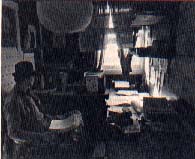 For Antic, it started here. Picture the heavy, clunky, handmade, wooden kitchen table in Jim's turn-of-the-century apartment on Potrero Hill, high above the city. From the street, you could see the fog curling over San Francisco's old industrial area, now gentrifying as the downtown financial district pushes South.
For Antic, it started here. Picture the heavy, clunky, handmade, wooden kitchen table in Jim's turn-of-the-century apartment on Potrero Hill, high above the city. From the street, you could see the fog curling over San Francisco's old industrial area, now gentrifying as the downtown financial district pushes South.
"When Jim said, 'Let's start a magazine,' I said, 'Sure, why not? Then I got second thoughts--I had less than a year of production experience. In a way, I was terrified," recalls Marni Tapscott, the slim, soft-spoken co-founder and art director of Antic Publishing. "I would never have imagined then that today, four years later, I would be sitting in this office and making a real salary and producing two magazines," she says. "But we did it."
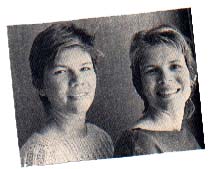 Jim says, "We were sitting down to breakfast one day and having blueberry pancakes and Marni said, 'What about a computer name? You know, like BYTE.' And so that got me thinking about computer stuff and out popped ANTIC--short for Alpha Numeric Television Integrated Circuit, which is one of the 8-bit Atari special chips." Marni said, "Let's make the letters sort of like they're dancing accross the top of the page." And within minutes she had the cockeyed Antic logo.
Jim says, "We were sitting down to breakfast one day and having blueberry pancakes and Marni said, 'What about a computer name? You know, like BYTE.' And so that got me thinking about computer stuff and out popped ANTIC--short for Alpha Numeric Television Integrated Circuit, which is one of the 8-bit Atari special chips." Marni said, "Let's make the letters sort of like they're dancing accross the top of the page." And within minutes she had the cockeyed Antic logo.
At the next ABACUS meeting, Jim announced he would be starting a magazine and asked for volunteers. Robert DeWitt stood up.
Four years later, the founding staff members are still here: (above) Les Torak working in Jim's apartment. (right) Linda and Marni Tapscott. (below) Robert DeWitt: From enthusiast to editor.
DeWitt, who had a journalism background, was fresh out of Control Data Computer Institute and Iooking for a programming job. ''Jim said he was starting a magazine, I said I'd help for free--which was a good thing, because he didn't have any money to pay me," he says. DeWitt is a complement to Jim. Where Jim is energetic and intense, DeWitt is methodical and mellow. But they had one thing in common-Atari. "Jim had never been in business before. I was new to business, too. But not knowing any better, you'll do things that nobody would ever try. People said it would take a quarter of a million dollars to start a magazine. We'll, Jim didn't even have his rent money that month."
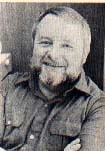 "I called advertisers cold." Jim says. "I told them 'I have a magazine, would you like to buy ads.' Out of the blue. They had no idea who I was. But my uncle, an attorney with computer industry contacts, said, 'Enthusiasm--and I hear it in your voice--makes up for everything.'" Jim sold over $5,000 woth of ads for a non-existant magazine.
"I called advertisers cold." Jim says. "I told them 'I have a magazine, would you like to buy ads.' Out of the blue. They had no idea who I was. But my uncle, an attorney with computer industry contacts, said, 'Enthusiasm--and I hear it in your voice--makes up for everything.'" Jim sold over $5,000 woth of ads for a non-existant magazine.
"One advertiser I called asked, 'Have you ever dealt with advertisers before?' I said 'No.' 'Do you know what advertising copy looks like?' 'No.' 'Do you have distribution?' And I said, 'No.' He said, 'Give me a full page.' He had to pay in advance, too." Of course, that says a lot about the optimism and buoyancy of the industry at the time.
Many of those first advertisers also began life as kitchen table operations. Broderbund, Optimized Systems Software, Adventure International, DataSoft and particularly Synapse, played an important role in Antic's success as they grew.
Another early supporter was Sierra On-line, a rapidly growing company then known as On-Line Systems and running out of programmer Ken Wiilliam's house in the Sierra foothills. John Williams, Ken's younger brother and now Vice president of the company recalls, "I remember what Jim said when he was starting Antic. "The Atari is the real home computer. We're tired of just hearing about the Winners--we're going to write about the little guys too." Online Systems bought the back page of the first issue. "To a certain extent, the Atari enthusiasts were renegades," Williams says.
At the end of March, 1982, the first issue of Antic debuted at the West Coast Computer Faire in San Francisco. Jim and DeWitt crammed 1,500 copies of the new magazine into Jim's Subaru and lugged them through driving rain down the long ramp into Brooks Hall--where about 300 copies got sold. "It wasn't the great success we had hoped for, DeWitt says.
"I dont know what I thought would happen," Jim says. "But there we were, stuck with 12,700 of the 13,000 magazines I had printed."
THE WALL
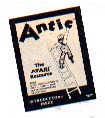 'When I walked into Jim's apartment I saw 120 boxes of magazines stacked to the ceiling in the little living room," says Les Torok, Antic employee #4 . "We never thought we'd see the end of that first issue." A musician, a film and writing student, Les became Circulation Director.
'When I walked into Jim's apartment I saw 120 boxes of magazines stacked to the ceiling in the little living room," says Les Torok, Antic employee #4 . "We never thought we'd see the end of that first issue." A musician, a film and writing student, Les became Circulation Director.
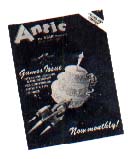 Eventually that stack of magazines became known as "The Wall of Torok.'' But as the stack grew smaller, it became a visual presentation of sales. "When Jim or I got an order we'd yell, 'All right! I've got 10!' or 'I've got 15!' across the room," Les says. By the fourth issue, 580 checks arrived in one day. Within six months, the first issue sold out and became a collectors item.
Eventually that stack of magazines became known as "The Wall of Torok.'' But as the stack grew smaller, it became a visual presentation of sales. "When Jim or I got an order we'd yell, 'All right! I've got 10!' or 'I've got 15!' across the room," Les says. By the fourth issue, 580 checks arrived in one day. Within six months, the first issue sold out and became a collectors item.
For the first month, Les's office was a corner of the room where he worked on a large, pillow with his legs crossed, filling out order slips. "It was like an MBA education in 30 seconds," he says. There were no names. No lists. He got the yellow pages for every computer store listing in the nation and copied them down. "Then I spent the next 1 1/2 years on the phone." He called dealers and begged them to sell just 10 magazines a month. "We were totally naive, but we learned fast."
The first bi-monthly issue was 30 pages. By issue number five, it grew to 112 pages. For the first Christmas cover, Antic contracted artist Tim Boxell, who did the Synapse package illustrations. There was a small problem with that issue-they forgot to put on the price.

Issue number one(top) "Some of us are computer proffessionals," Jim Capparell wrote in his first editorial, "And some of us are what I've come to call Atari Proffessionals--very motivated users." By issue seven, (second down) it was a full-color monthly. (right above) Atari advertisement circa 1982: Power had a price.
THE MOGUE
For the first year, everybody called Jim "the Mogue," for mogul. It was a joke, of course. "We weren't a big power in the Atari field," DeWitt says. "Atarr didn't take us seriously" But Steve Ross, chairman of Atari's parent company, Warner Communications, did. He sent a note with a personal check for a subscription.
"Atari hardly noticed us at first. They were business people--we were enthusiasts. We were like the poor cousin who didn't get invited to the wedding," Jim says.
Atari, Inc. was now the fastest-growing company in U.S. history, with sales peaking at $2 billion. 1982 was the year of the Pac Man, and people were dropping $5 billion worth of quarters into arcade machines worldwide. With Ray "The Czar" Kassar at the helm, more than 15 million 2600 game machines had been sold.
Atari was synonymous with videogames, and by comparison the 400/800 personal computers went almost unnoticed. The computers were never a big moneymaker for Atari--some say they never made any money at all. But eventually, Atari quietly sold more than 1.5 million 8-bit computers.
VOLUME 1, NUMBER 1
In January, 1983 Antic moved a few blocks down the street to an office above a sleazy bar across from the port in San Francisco's China Basin area. Phil the bartender often had fights with the patrons. The cops hung out. "Some pretty ripe language floated up into our office." DeWitt says. "Accounting was still so bad we didn't know if we were making it or not."
A former San Francisco Boat Works employee was brought in as Senior Editor. He arrived with a truckful of furniture, including fancy paintings of yachts. "On his first day we had a staff meeting and he ordered an iced tub of beer brought up from the bar," DeWitt says. "Then he pulled a baseball out of his pocket and said, "We're playing hardball now." He didn't last very long.
1983 is another good year for Antic, software companies and dealers. But trouble is beginning to brew at Atari as corporate spending still runs wild, and the videogame craze cools. Stock in Warner Communications, Atari's parent company, falls from $54 a share to below $30 in seven days. By March 1983, Atari has its first wave of layoffs--1,700 employees get the axe. Feeling the heat from the Commodore 64, Atari releases the 1200XL, a computer with software compatibility problems that killed it in less than a year. Then Atari announces a new computer, the 1450XLD, with a built-in double sided drive, modem and voice synthesizer--but never releases it.
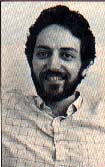 Gary Yest (right) was a hardware enthusiast. He'd earned a sound engineering certificate and he had worked the mixing board on a major rock tour. Knowing that he was about to enter the hospital for experimental surgery on an extended and possibly fatal illness, he wrote a letter to Atari president Ray Kassar. He offered to donate his time for the entire year that he expected to be bedridden. He ended the letter: "Is there still a Santa Claus?" Atari's public reputation was far from altruistic, so it was all the more shocking when Santa Claus made a delivery.
Gary Yest (right) was a hardware enthusiast. He'd earned a sound engineering certificate and he had worked the mixing board on a major rock tour. Knowing that he was about to enter the hospital for experimental surgery on an extended and possibly fatal illness, he wrote a letter to Atari president Ray Kassar. He offered to donate his time for the entire year that he expected to be bedridden. He ended the letter: "Is there still a Santa Claus?" Atari's public reputation was far from altruistic, so it was all the more shocking when Santa Claus made a delivery.
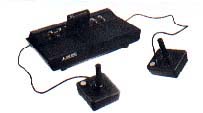 An enormous 6x4 foot box arrived. Literally, everything was inside--an Atari computer,software. As an Atari Foundation Fellow in educational research, Gary was put to work doing testing and market evaluation of the Plato Learning Phone system. "I was blown away by the Atari technology, but I didn't know what to do with it," Gary says. Atari referred him to Jim Capparell. During his time in the hospital, Gary and Jim developed a telephone friendship without meeting each other in person. Gary, who is married and has a daughter, joined the Antic staff in April, 1983.
An enormous 6x4 foot box arrived. Literally, everything was inside--an Atari computer,software. As an Atari Foundation Fellow in educational research, Gary was put to work doing testing and market evaluation of the Plato Learning Phone system. "I was blown away by the Atari technology, but I didn't know what to do with it," Gary says. Atari referred him to Jim Capparell. During his time in the hospital, Gary and Jim developed a telephone friendship without meeting each other in person. Gary, who is married and has a daughter, joined the Antic staff in April, 1983.
In July 1983, Ray Kassar resigns, and James Morgan is brought in as president. The price of the Atari 800 drops to $165. At the June Consumer Electronics Show, Atari announces the 600XL and 800XL computers and signs television star Alan Alda to promote the new models with the slogan, "We made them smart enough to know you're only human." However, Atari continues to lay off employees and loses $450 million that year.
(Top) The 2600: Atari was plagued with a gane machine image. (below) Desperate to compete with the Commodore 64 and Apple II, Atari releases the XL computers and signs on M*A*S*H star Alan Alda to promote them.
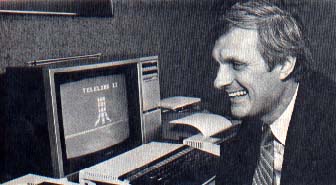 Christmas, 1983 was Antic's largest issue--148 glossy pages. Early in 1984, the magazine moved several blocks closer to downtown to the current offices, in a bright, spacious, renovated loft building that formerly housed a dress manufacturer. The kitchen table was retired to the apartment of Linda Tapscott, Marni's younger sister who had joined the art department as Antic employee #5.
Christmas, 1983 was Antic's largest issue--148 glossy pages. Early in 1984, the magazine moved several blocks closer to downtown to the current offices, in a bright, spacious, renovated loft building that formerly housed a dress manufacturer. The kitchen table was retired to the apartment of Linda Tapscott, Marni's younger sister who had joined the art department as Antic employee #5.
Then DeWitt burned out from editing Antic. He bought a mobile home and went to Baja. "It really freaked us out." Jim says. "DeWitt was always the stable and organized editorial genius. I needed someone who can follow up." He brought in Nat Friedland, a former Billboard music journalist.
In February, 1984, Jack Tramiel, who built Commodore Business Machines from a typewriter shop into a $1 billion industry, resigns from Commodore and mysteriously disappears for four months. In July, 1984, Tramiel resurfaces in Sunnyvale, buys Atari, Inc. for $240 million, changes the name to Atari Corp. and rocks the industry.
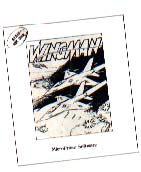 It was a new chapter for the industry, Chapter 11. Bankruptcy. "Advertisers were going out of business--our ad sales dropped 50 percent in 50 days. Advertisers didn't pay us. But we never had to lay off a single employee." Jim Capparell is proud of that. "We just had to learn how to do better business."
It was a new chapter for the industry, Chapter 11. Bankruptcy. "Advertisers were going out of business--our ad sales dropped 50 percent in 50 days. Advertisers didn't pay us. But we never had to lay off a single employee." Jim Capparell is proud of that. "We just had to learn how to do better business."
Nobody knew what was going to happen next. "So what," Jim says, "without enthusiasm, having lots of money to throw at a project can just be a detriment, because you stop thinking creatively and just start thinking more money will help." Enthusiasm was put to a brutal test.
(Right) Before the advent of slick boxes replete with posters and space fluff, most software, like this early Microprose release, was simply packaged in Zip Loc bags.
In order to get through the lean period, Jim and the Antic staff came up with a number of unusual magazine business innovations. They started the Antic Action Edition, the magazine packaged with a disk containing all the programs from the issue. Then came ANTIC ONLINE, an electronic magazine on CompuServe that covers Atari news much faster than a monthly publication could. Antic kicked off the Worldwide Users Network (WUN), an alliance of Atari users groups.
The magazine's series of public domain disks expanded into today's 40-page Antic Catalog under Marketing Director Gary Yost. "The catalog started as an experiment," Jim says." But it kept the magazine afloat through the lean year and has now grown to more than 250 products.
At the January, 1985 Consumer Electronics Show, like a phoenix rising from the ashes of charred silicon chips and faded dreams, the Atari 520ST computer is born. If the Atari 800 was the Apple II reincarninated and improved, the ST was the Apple Macintosh done one better. The industry promptly calls it the "Jackintosh." The users start calling Tramiel "Uncle Jack."
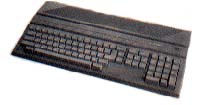 Unbelievably, the price of this 520K high-resolution super-Mac was less than the original Atari 8O0 with 16K memory. Suddenly the spirit of computing's early days returned, with a host of new believers and entrepreneurs. Antic Associate Editor Jack Powell was assigned to start the ST Resource, a magazine within a magazine.
Unbelievably, the price of this 520K high-resolution super-Mac was less than the original Atari 8O0 with 16K memory. Suddenly the spirit of computing's early days returned, with a host of new believers and entrepreneurs. Antic Associate Editor Jack Powell was assigned to start the ST Resource, a magazine within a magazine.
In 1983, over 450 different computer magazines clogged the shelves. After the 1985 shakeout, only a fraction remained. It was a crazy time to start a new magazine. But in April, 1985, Jim coaxed DeWitt back to start II Computing, a new magazine for Apple II users. With another magazine under the roof, the staff mushroomed. Pinstripes began to encroach upon Antic's casual bluejean style as financial and accounting professionals moved in. At one point, new staffers were forced to put their desks in the front lobby.
Four years. It's an eternity in Antic time. As we celebrate our fourth anniversary, 3.5 million copies later, the office is still a cacaphony of computer game blips and crashes, screeching printers, crying babies and incessantly ringing phones with readers on the line asking questions. Computer executives often visit the office, as well as gangly, nervous 17-year-old programmers demonstrating their newest software. Hundreds of letters pour in weekly. Some are new products and software that will be opened like special Christmas presents, others are pleas from confused Atari users for help and guidance.
Over the years, Antic contributors included well-known Atari programmers such as Chris Crawford, Bill Wilkinson, Russ Wetmore, Stan Ockers, Jerry White, Tim Oren, Ron Luks, David Plotkin, Ken Harms, Matt Ratcliff, Karl Wiegers, Paul Chabot, Chris Chabris, J.D. Casten, Len Dorfman--and too many others to name them all. But many contributors have simply been regular Antic readers with good ideas. If there is any single thing that made the magazine a success, it was the enthusiasm of those readers.
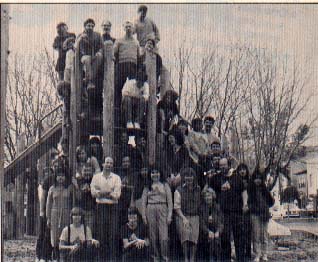 "In a way, the fact that Atari and its audience were always underdogs helped to unify us," Jim says. "Everybody said it was just a game machine. Well, we got sick of hearing that. We all knew the Atari was a great computer in spite of what the press and anyone else said. It's still the case now. There's tremendous loyalty in the Atari market and among our readers."
"In a way, the fact that Atari and its audience were always underdogs helped to unify us," Jim says. "Everybody said it was just a game machine. Well, we got sick of hearing that. We all knew the Atari was a great computer in spite of what the press and anyone else said. It's still the case now. There's tremendous loyalty in the Atari market and among our readers."
On the wall of Jim's office are photographs of Robert DeWitt, Les Torok, Marni and Linda Tapscott. If you didn't know these people were the founders of Antic, you might think they were family. And in a way, they are a family-- now grown to more than 40 employees and some 100,000 readers spanning the world.